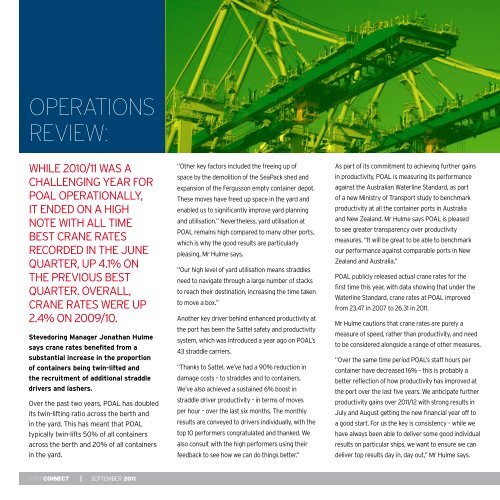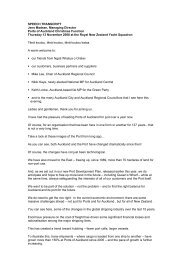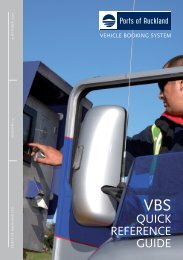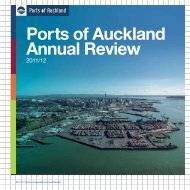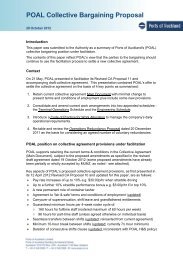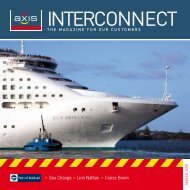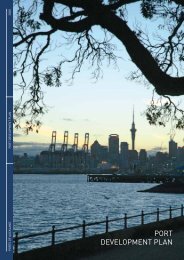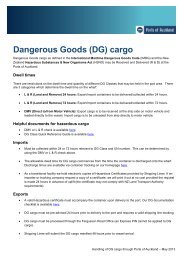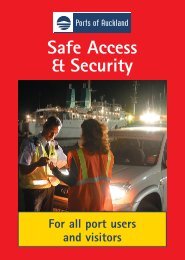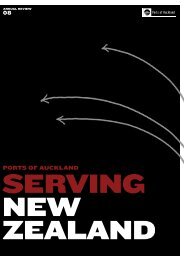Crane Rates Soaring > Top Class Lashing ... - Ports of Auckland
Crane Rates Soaring > Top Class Lashing ... - Ports of Auckland
Crane Rates Soaring > Top Class Lashing ... - Ports of Auckland
You also want an ePaper? Increase the reach of your titles
YUMPU automatically turns print PDFs into web optimized ePapers that Google loves.
OPERAtIONS<br />
REVIEW:<br />
wHILE 2010/11 wAS A<br />
CHALLENGING yEAR FOR<br />
POAL OPERATIONALLy,<br />
IT ENdEd ON A HIGH<br />
NOTE wITH ALL TIME<br />
BEST CRANE RATES<br />
RECORdEd IN THE JUNE<br />
qUARTER, UP 4.1% ON<br />
THE PREvIOUS BEST<br />
qUARTER. OvERALL,<br />
CRANE RATES wERE UP<br />
2.4% ON 2009/10.<br />
Stevedoring Manager Jonathan Hulme<br />
says crane rates benefited from a<br />
substantial increase in the proportion<br />
<strong>of</strong> containers being twin-lifted and<br />
the recruitment <strong>of</strong> additional straddle<br />
drivers and lashers.<br />
Over the past two years, POAL has doubled<br />
its twin-lifting ratio across the berth and<br />
in the yard. This has meant that POAL<br />
typically twin-lifts 50% <strong>of</strong> all containers<br />
across the berth and 20% <strong>of</strong> all containers<br />
in the yard.<br />
SEPTEMBER 2011<br />
“Other key factors included the freeing up <strong>of</strong><br />
space by the demolition <strong>of</strong> the SeaPack shed and<br />
expansion <strong>of</strong> the Fergusson empty container depot.<br />
These moves have freed up space in the yard and<br />
enabled us to significantly improve yard planning<br />
and utilisation.” Nevertheless, yard utilisation at<br />
POAL remains high compared to many other ports,<br />
which is why the good results are particularly<br />
pleasing, Mr Hulme says.<br />
“Our high level <strong>of</strong> yard utilisation means straddles<br />
need to navigate through a large number <strong>of</strong> stacks<br />
to reach their destination, increasing the time taken<br />
to move a box.”<br />
Another key driver behind enhanced productivity at<br />
the port has been the Sattel safety and productivity<br />
system, which was introduced a year ago on POAL’s<br />
43 straddle carriers.<br />
“Thanks to Sattel, we’ve had a 90% reduction in<br />
damage costs – to straddles and to containers.<br />
we’ve also achieved a sustained 6% boost in<br />
straddle driver productivity – in terms <strong>of</strong> moves<br />
per hour – over the last six months. The monthly<br />
results are conveyed to drivers individually, with the<br />
top 10 performers congratulated and thanked. we<br />
also consult with the high performers using their<br />
feedback to see how we can do things better.”<br />
As part <strong>of</strong> its commitment to achieving further gains<br />
in productivity, POAL is measuring its performance<br />
against the Australian waterline Standard, as part<br />
<strong>of</strong> a new Ministry <strong>of</strong> Transport study to benchmark<br />
productivity at all the container ports in Australia<br />
and New Zealand. Mr Hulme says POAL is pleased<br />
to see greater transparency over productivity<br />
measures. “It will be great to be able to benchmark<br />
our performance against comparable ports in New<br />
Zealand and Australia.”<br />
POAL publicly released actual crane rates for the<br />
first time this year, with data showing that under the<br />
waterline Standard, crane rates at POAL improved<br />
from 23.47 in 2007 to 26.31 in 2011.<br />
Mr Hulme cautions that crane rates are purely a<br />
measure <strong>of</strong> speed, rather than productivity, and need<br />
to be considered alongside a range <strong>of</strong> other measures.<br />
“Over the same time period POAL’s staff hours per<br />
container have decreased 16% – this is probably a<br />
better reflection <strong>of</strong> how productivity has improved at<br />
the port over the last five years. we anticipate further<br />
productivity gains over 2011/12 with strong results in<br />
July and August getting the new financial year <strong>of</strong>f to<br />
a good start. For us the key is consistency – while we<br />
have always been able to deliver some good individual<br />
results on particular ships, we want to ensure we can<br />
deliver top results day in, day out,” Mr Hulme says.


